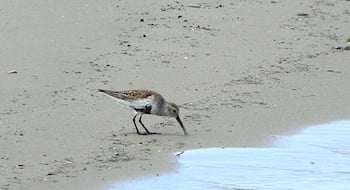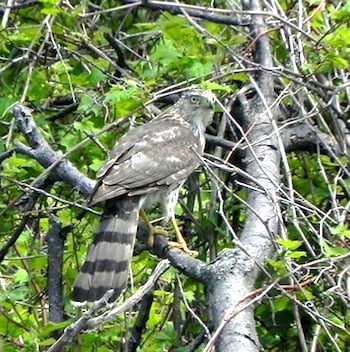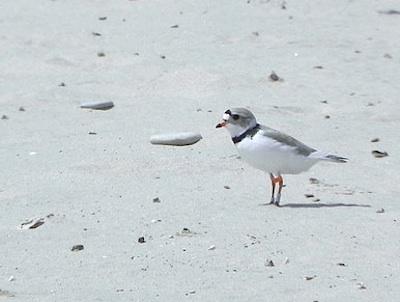Crossing the continent to visit an exotic park is always fun, but sometimes it’s nice to take a stroll out to the park in your proverbial backyard. Some of you may be lucky enough to have a park almost literally in your backyard, but for me it’s a 3-hour drive to my “home” park. Still, who can complain about being able to take a day-trip to Sleeping Bear Dunes National Lakeshore whenever the mood strikes?
Sleeping Bear isn’t known far and wide for its birding. There aren’t any rarities that show up with any regularity. There was that Great Shearwater from the Gulf of Mexico that Hurricane Isaac deposited there back in September, but for the most part the birding is a celebration of the expected.
Luckily, you can expect quite a lot on a Great Lakes shore in spring. For me, birding in Sleeping Bear begins with the Piping Plovers of Platte Point, which sounds a bit like the title of an aristocratic family and its estate. The plovers are indeed stately, and get enough paparazzi attention to be celebrities. Every May, they arrive back on the sandy beach near the mouth of the Platte River to look adorable and raise some youngsters. NPS biologists and volunteer monitors keep a close eye on the nesting action here and other nesting areas within the park. Chicks are banded with color-coded leg bands so their progress and eventual (hopefully!) return as nesting adults can be tracked.

A Dunlin working the beach over for a meal. Kirby Adams photo.
Access to the plovers is relatively easy. Unlike Cape Hatteras, where ORV use has resulted in large nesting closures (not to mention much consternation from all humans involved), the nesting closures in Sleeping Bear are small areas closed to foot traffic around the clusters of nests.
There are few problems with anyone violating the closures. Some volunteer monitors I ran into last May told me the worst thing that had happened on their watch was someone flying a kite near and over the nests. Unbeknownst to the kite-wrangler, the plover chicks were badly stressed and startled by the sudden appearance of a large raptor-like object above them. With the kite relocated to a ploverless area yards away, the chicks went about their business.
From the public beach at Platte Point, to get up close and personal with the plovers requires a wade across the mouth of the Platte River. If it’s been warm, this involves a thigh-deep wade that includes a startling change of temperature from the warm outflow of the Platte to the occasional cold wave of Lake Michigan.
Once on the other side, a birder can sit on the beach and watch the plover nests slightly inland in a protected and restricted area between a bend of the river and the lake. Getting down low will relax the birds. I’ve found a prone position can get the adults casually coming to within a few yards of my binoculars or camera.
It’s best to not make any sudden movements when the chicks are about, especially later in the nesting season when the young ones start making trips out of the closure and down to the water.
The beach is great for other shorebirds as well. The Piping Plover look-a-like Semipalmated Plovers are common during migration, as are Dunlin, Sanderling, and various small sandpipers. Duck and waterfowl watching is sharp from Platte Point.
Thousands of mergansers use the Lake Michigan shoreline for migration. Fall is particularly good for massive movements of Red-breasted and Common Mergansers. A lesser known nesting spot for Piping Plovers in Sleeping Bear is the beach of Good Harbor Bay on the north end of the park. The same conglomeration of shorebirds and ducks frequent this area, but there’s another resident nearby that attracts some attention.
The scrub on the small dunes behind the beach is some of the northernmost reliable nesting habitat for Prairie Warblers. These birds are relatively common in the southeast, but something of a rare treat in the upper Midwest. You would think with the name “Prairie” we’d have plenty of them, but the name is a misnomer. They demand successional vegetation, usually in poor-soiled areas. A prairie is not a place you’d look for a prairie warbler.
The scraggly vegetation of Great Lakes dunes tends to suit them quite well, though. So, despite it being a bit northerly, a few hardy males set up territory near Good Harbor Bay regularly. They don’t show themselves well, so learning their song is a great help in finding them. Just remember, it’s illegal to play a recording of their song to draw them into the open within the national park!
Away from the shore, Sleeping Bear provides the same spectacular woodland birding as other areas of the Midwest with warblers, thrushes, vireos, owls, and hawks. While the fragmentation of forest is a concern for nesting woodland species, the meadows and fields in and around Sleeping Bear provide some excellent habitat for birds like Upland Sandpipers, Bobolinks, and Grasshopper Sparrows.

Look carefully and you might spy a Cooper's hawk at Sleeping Bear Dunes. Kirby Adams photo.
All of those species are struggling across the continent as grassland habitat vanishes, but all three can be spotted with some observation of appropriate meadows during nesting season.
In all, about 240 species of bird have been recorded in the park. I’m considering a Sleeping Bear “big day” this spring to see how many birds I can find within the national lakeshore in 24 hours. One-hundred-and-twenty or so should be an easy target. The biggest problem will be tearing myself away from the stunning scenery long enough to keep looking for new birds.
That’s not a bad problem to have.


 Support Essential Coverage of Essential Places
Support Essential Coverage of Essential Places






